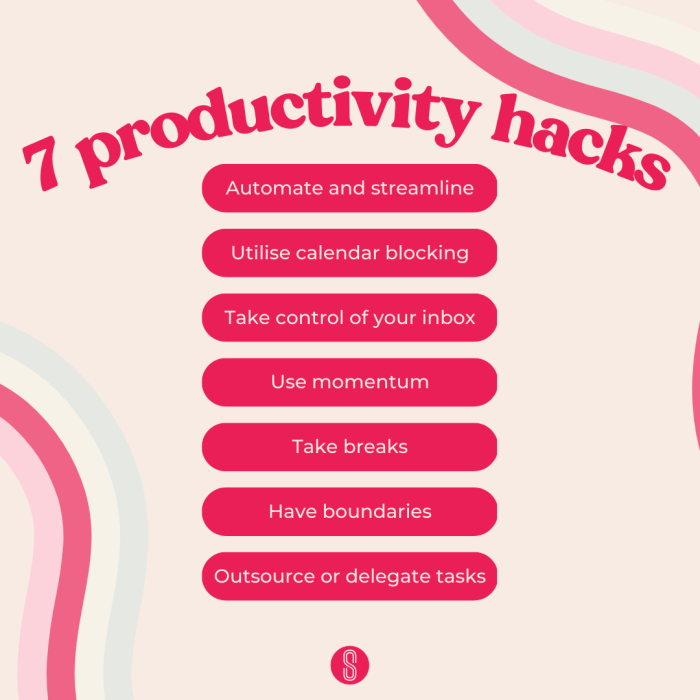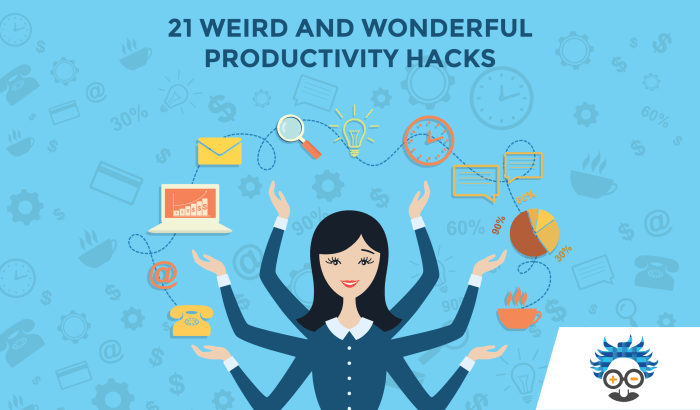Productivity Hacks are the secret sauce to maximizing your time and getting things done efficiently. Dive into this guide filled with innovative strategies to supercharge your productivity game.
From time management techniques to organization tips, and from utilizing technology tools to prioritizing health and wellness, this comprehensive overview will revolutionize how you approach productivity.
Introduction to Productivity Hacks
Productivity hacks are strategies or techniques that individuals can implement to streamline their work processes and optimize their time and efficiency, whether in a professional or personal setting.
These hacks are essential for maximizing productivity as they help individuals prioritize tasks, minimize distractions, and make the most out of their time. By incorporating productivity hacks into daily routines, individuals can achieve more in less time and maintain a better work-life balance.
Benefits of Productivity Hacks
- Increased Efficiency: Productivity hacks enable individuals to work smarter, not harder, by focusing on high-priority tasks and eliminating time-wasting activities.
- Improved Time Management: By implementing productivity hacks, individuals can better allocate their time to tasks that matter most, leading to increased productivity and reduced procrastination.
- Reduced Stress: With better organization and time management, individuals experience less stress and overwhelm, resulting in a more positive and productive work environment.
- Enhanced Work-Life Balance: Productivity hacks help individuals accomplish tasks more efficiently, allowing for more time to dedicate to personal activities and relationships outside of work.
Time Management Strategies
Effective time management is crucial for maximizing productivity and achieving goals. By implementing the right techniques, individuals can make the most out of their time and accomplish tasks efficiently.
Setting Priorities
- Identify the most important tasks that need to be completed.
- Use tools like Eisenhower Matrix to categorize tasks based on urgency and importance.
- Focus on high-priority tasks first to ensure critical work is completed.
Setting Realistic Deadlines
- Avoid overcommitting by setting achievable deadlines for tasks.
- Break down larger projects into smaller milestones with specific deadlines.
- Consider the time required for each task and allocate enough time to complete them.
Organization Tips
When it comes to boosting productivity, staying organized is key. A clutter-free workspace can help you focus better and get tasks done efficiently. In addition, having a system in place for managing digital files and creating to-do lists can make a huge difference in your productivity levels.
Declutter Your Workspace
Decluttering your workspace is essential for improving focus and productivity. A clean and organized workspace can help reduce distractions and promote a sense of calm, making it easier to concentrate on the task at hand.
Organizing Digital Files
Efficiently organizing your digital files and documents can save you a lot of time and frustration. Create folders with clear labels and subfolders to categorize your files logically. Use a consistent naming convention to make it easier to search for specific documents.
Create a To-Do List
Creating a to-do list is a great way to stay on top of your tasks and manage your time effectively. Write down all the tasks you need to accomplish, prioritize them based on importance, and set realistic deadlines. Checking off tasks as you complete them can give you a sense of achievement and motivation to keep going.
Technology Tools for Productivity: Productivity Hacks

When it comes to boosting productivity, leveraging technology tools can make a huge difference in how efficiently you work. From task management apps to project collaboration software, there are plenty of tools out there designed to help you stay organized and focused.
Popular Productivity Apps and Software
- Todoist: A task management app that lets you create to-do lists, set reminders, and prioritize tasks for better time management.
- Evernote: A note-taking app that allows you to capture ideas, organize notes, and collaborate with team members on projects.
- Trello: A project management tool that uses boards, lists, and cards to help teams organize and prioritize tasks in a visually appealing way.
- Google Drive: A cloud storage and file-sharing service that allows teams to collaborate on documents, spreadsheets, and presentations in real-time.
Benefits of Using Project Management Tools for Team Collaboration
Project management tools like Asana or Monday.com help teams stay on track by assigning tasks, setting deadlines, and tracking progress in a centralized platform.
- Improved Communication: Team members can easily communicate, share files, and provide updates on project status within the software.
- Enhanced Visibility: Managers can track individual contributions, identify bottlenecks, and make data-driven decisions to optimize workflow.
- Increased Accountability: By assigning tasks and deadlines, project management tools ensure team members are accountable for their responsibilities.
Automation Tools for Streamlining Repetitive Tasks
Automation tools like Zapier or IFTTT help streamline repetitive tasks by connecting different apps and automating workflows.
- Email Marketing Automation: Tools like Mailchimp or HubSpot automate email campaigns, follow-ups, and customer segmentation for efficient marketing strategies.
- Social Media Scheduling: Platforms like Buffer or Hootsuite allow users to schedule posts, monitor engagement, and analyze performance across multiple social media channels.
- Data Entry Automation: Software like UiPath or Automation Anywhere can automate data entry tasks, reducing errors and saving time on manual data input.
Health and Wellness Practices
Maintaining good physical health is crucial for enhancing productivity in all areas of life, including work. When our bodies are healthy, our minds are sharper, and we can focus better on tasks at hand. Here are some tips for incorporating health and wellness practices into your daily routine.
Exercise Breaks
Taking short exercise breaks throughout the workday can help boost energy levels, improve mood, and increase productivity. Here are some ways to incorporate exercise into your daily schedule:
- Take a brisk walk around the office building during breaks
- Do a quick workout routine at your desk, including stretches and strength exercises
- Use a standing desk or take standing breaks to reduce sedentary time
- Join a virtual fitness class during lunchtime to stay active and energized
Work-Life Balance
Maintaining a healthy work-life balance is essential for overall well-being and productivity. Here are some strategies to achieve a better balance:
- Set boundaries between work and personal time to prevent burnout
- Schedule regular breaks and time for relaxation to recharge your energy
- Prioritize self-care activities such as hobbies, exercise, and spending time with loved ones
- Avoid overworking and learn to say no to tasks that can wait
Mindfulness and Mental Health

Mindfulness and mental health play a crucial role in productivity. By reducing stress and improving focus, individuals can enhance their overall well-being and efficiency in various aspects of life.
Mindfulness Techniques for Reducing Stress and Improving Focus, Productivity Hacks
Practicing mindfulness can help individuals alleviate stress and enhance concentration. Some techniques include:
- Breathing exercises to center oneself and calm the mind.
- Body scanning to bring awareness to physical sensations and release tension.
- Mindful meditation to focus on the present moment and let go of distractions.
Impact of Mental Health on Productivity
Mental health significantly influences productivity levels. When individuals struggle with mental health challenges, such as anxiety or depression, it can impair their ability to focus, make decisions, and perform effectively in their tasks.
Strategies for Managing Distractions in the Workplace
Distractions in the workplace can hinder productivity. To manage distractions effectively, consider the following strategies:
- Establishing a designated work area free from distractions.
- Utilizing time management techniques, such as the Pomodoro method, to stay focused and productive.
- Setting boundaries with colleagues and limiting non-essential communication during work hours.